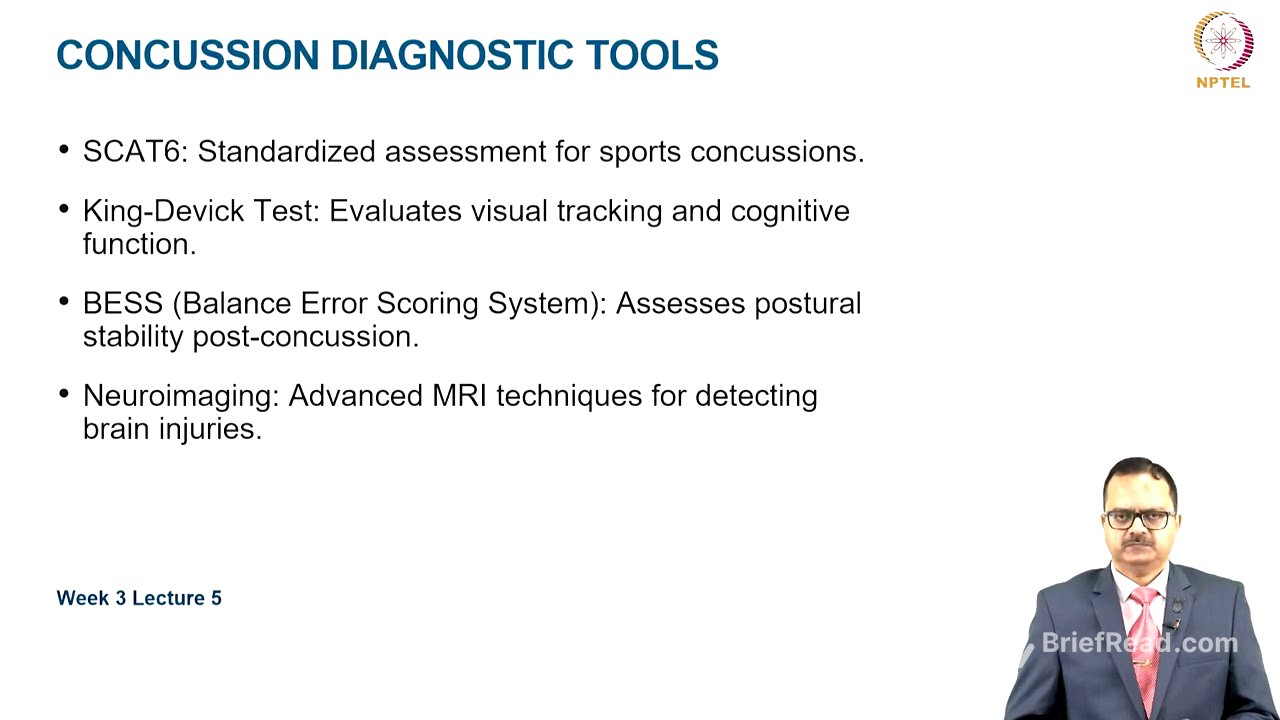TLDR;
This lecture explores the advances in diagnostic technologies for sports injuries, emphasizing the importance of early and accurate diagnosis for optimizing treatment, rehabilitation, and injury prevention. It covers current imaging modalities like X-rays, MRI, CT scans, and musculoskeletal ultrasound, as well as newer technologies such as surface EMG, isokinetic dynamometry, motion capture systems, force plates, wearable sensors, thermography, and blood biomarkers. The lecture also discusses functional movement screening, concussion diagnosis tools, AI applications, virtual reality in rehabilitation, biomechanical assessments, pressure mapping, EEG, tendon stiffness testing, gate analysis, advanced ultrasound, and genetic testing. Finally, it touches on future trends, challenges, and the critical implications of these advancements in sports medicine.
- Importance of accurate and early diagnosis in sports injuries
- Overview of current and emerging diagnostic technologies
- Role of AI and virtual reality in sports medicine
Introduction [0:15]
The lecture emphasizes the crucial role of accurate and early diagnosis in sports injuries, highlighting the evolution of diagnostic techniques from traditional methods to high-tech solutions. Advanced diagnostics are essential for optimizing treatment, rehabilitation, and injury prevention in sports medicine. The objectives include understanding advanced diagnostic methods, exploring their benefits and limitations, and discussing emerging trends in sports injury diagnostics.
Current Available Modalities [2:17]
Currently used imaging modalities in sports medicine include X-rays for detecting fractures and joint abnormalities due to their cost-effectiveness and wide availability. MRI is the gold standard for soft tissue injuries, detecting ligament, tendon, and muscle damage, although it is more expensive. CT scans provide high-resolution imaging of complex fractures and bony stress injuries. Musculoskeletal ultrasound is used for real-time imaging of tendons and ligaments, as well as for guided injections, offering portability and dynamic assessment capabilities.
Newer Modalities [3:07]
Surface EMG (SEMG) uses electrodes to measure electrical activity in muscles, assessing neuromuscular function and detecting imbalances or fatigue. Isokinetic dynamometry is the gold standard for muscle strength analysis, measuring strength, endurance, and power at controlled speeds, and identifying muscle imbalances. Motion capture systems, particularly 3D systems, assess movement biomechanics to detect deficiencies that may contribute to injuries, aiding return-to-play decisions and technique refinement. Force plates measure ground reaction forces during movements like jumping and landing, assessing balance, limb asymmetry, and injury risk, often used with 3D motion analysis. Wearable sensors and GPS tracking monitor movement patterns, workload, and fatigue to prevent overuse injuries, providing real-time data to coaches and medical staff. Thermography uses infrared imaging to detect temperature changes in muscles and joints, identifying inflammation and overuse injuries non-invasively. Blood biomarkers detect markers of muscle damage, inflammation, and fatigue, aiding recovery planning and readiness certification. Functional movement screening (FMS) evaluates movement patterns to identify injury risks and plan rehabilitation. Tools for concussion diagnosis include SCAT 6, King-David Twist, and the Balance Error Scoring System, along with advanced MRI techniques for detecting brain injuries.
AI and Rehabilitation [9:07]
AI in sports medicine involves AI-driven models for injury risk prediction and machine learning algorithms for gait and movement analysis. AI-assisted image interpretation is used for faster and more accurate diagnosis in imaging. Virtual reality (VR) based functional testing is used in rehabilitation for neuromuscular testing, training, and rehabilitation, offering a safe, simulated environment for balance and coordination training, enhancing cognitive motor integration.
Biomechanical Assessments and Advanced Technologies [10:08]
Biomechanical assessments use kinetic and kinematic analysis to evaluate joint function, identifying improper mechanics that contribute to injuries and aiding technique modification. Pressure mapping systems analyze foot pressure distribution during gait and running, identifying faulty mechanics and informing the design of custom orthotics. EEG monitors brain activity, assessing cognitive performance, reaction time, and neural recovery post-concussion. Tendon and ligament stiffness testing uses elastography to assess tissue elasticity, aiding early detection of tendinopathy and monitoring soft tissue healing. Gate analysis systems evaluate walking and running biomechanics to detect asymmetries and correct improper loading patterns. Advanced ultrasound techniques, such as elastography, measure muscle and tendon stiffness, while Doppler ultrasound assesses vascular injuries and inflammation, and dynamic imaging guides injections and assesses joint stability in real-time.
Genetic Testing [12:33]
Genetic testing in sports medicine identifies genetic predispositions to injuries like tendon ruptures, personalizing training and recovery programs and optimizing athlete performance. It can also be used for talent identification and development by identifying specific genes responsible for muscle performance and endurance.
Future Trends, Challenges, and Implications [13:14]
Future trends in sports injury diagnostics include AI and machine learning integration, the development of portable real-time diagnostic devices, and advancements in regenerative medicine and imaging techniques. Challenges include the high costs of advanced diagnostic tools, the need for specialized training to interpret data, and standardization issues in newer technologies. These technologies improve accuracy in sports injury diagnosis, enable faster rehabilitation with precise monitoring, and enhance athlete performance through individualized assessments.
Take-Home Message [14:26]
Advanced diagnostics are revolutionizing sports medicine, with early detection and personalized rehabilitation enhancing outcomes for athletes. Continuous innovation is driving better athlete care and performance optimization, making it an exciting time for advancements in diagnosis and treatment in sports medicine.









